Le lac du Der-Chantecoq
Der Chantecoq Lake : a regulator
Covering 4,800-hectares, lake Der-Chantecoq is the second largest artificial lake in western Europe. This reservoir was created to regulate the river Seine to avoid its devastating floodings in Paris and to support its flow in summer. The lake is fed by a canal that branches off the river Marne in Saint-Dizier and the outflow is a canal that joins the Marne in Arrigny.
Interest of the lake for birds
Situated on a major migration route between the northern breeding grounds and the wintering areas of France, Spain and Africa, it started attracting numerous species of birds as soon as it was created in 1974.
The filling up of the lake between December and June followed by its drain between July and November make the landscapes change drastically. When the water recedes, mudflats appear, attracting waders, ducks and geese, gulls but also the emblematic Common Crane thanks to which this site has acquired its international reputation.
The lake and the cranes
Lake Der-Chantecoq is very attractive for the Common Crane. It provides this bird :
- a vast open space which is ideal for this wary bird
- predator free islands where thousands of cranes can gather every evening and spend the night from October to March
- pastures, meadows, oaks providing acorns, and fields (corn fields in particular) all around the lake
- a vast undisturbed space, as the access to most of the lake is forbidden at this time of the year.
This lake is the main stopover and wintering site in Europe for this species. Every year, between 200,000 and 350,000 cranes stop there, either for a few hours or to overwinter. The last record dates back to 11th November 2014 when 206,000 Common Cranes where counted as they were leaving the lake early in the morning ! Some 20,000 to 30,000 cranes now regurlarly overwinter there.
This lake is a wintering site of major importance in Europe for many species of birds, therefore its preservation is essential.
History of the counts
A particular attention is paid to this species and numerous data have been collected :
- Synthesis of the survey work carried out (maximum number of birds per period of ten days)
- Historic of all crane counts on the main European sites (the page opens on the counts at Lac du Der. Use the tabs at the bottom of the page to display another site)
Translation : Gérard Rolin
Hesse
In the Hesse region, the migration of Common Cranes has been followed since 1987.
In Autumn and spring, 20 to 25 people count the migrating cranes every day. Martin Kraft sends the results of the counts to the migration specialists every evening through the list « grus-grus ».
These counts are very important for the survey of cranes in Europe and particularly in autumn for France as the birds which are seen in the Hesse region will normally then head towards the north-east of France (Lorraine and Champagne-Ardenne).
To get an optimal visibility, the counts are made from several places situated on higher elevations, between 300 and 400 metres above see level around Marbourg, on a 70- kilometre long line roughly centred on Marbourg, between Alsfeld (40 km east of Marbourg) and Herborn (30 km south-west of Marbourg).
The most important of these places are the roof of the Department of biology in the Marburg Lahn mountain (some 400 metres above see level), the Marburger Hasenkopf, west of Marbourg (340 metres) and the Altenberg in Odenhausen in the Lahn valley, about 17 km south of Marbourg (300 metres).
Informations : Martin Kraft.
Hortobágy National Park
The Common Crane was a breeding species in Hungary up to the end of the 19th century, the start of the water regulation programmes carried out alongside the course of the large rivers and connecting marshlands. However, Hungary is one of the most important staging-over sites for the Common Crane in Europe as outlined in the followings.
Up to the end of the 1970-ies, Lake Kardoskút in South-Hungary was the most important roost site for cranes during spring and autumn migration periods.
From the beginning of the 1980-ies, its role was more and more taken by some artificial fishponds in the Hortobágy, which can be explained by the following reasons:
- desiccation of the Lake Kardoskút because of a long droughty period
- intensive hunting in the same spot
- reduced hunting activities in the Hortobágy
- fortunate, but unvoluntary synchronization of draining large fishponds (normal way of fishing) and peak time of migration.
Consequently, the peak number of staging cranes in the Hortobágy increased from 3,000 in 1983 to 65,000 to 1993 and then to 120,000 in 2015, which still continues to increase . Cranes roost in 3-15 roost sites annually depending on the amount of precipitation filling up marshes. Roost sites are occupied by 2,000-70,000 cranes from mid-September to late November with peak numbers in late October.
However, it is important to note the increase of the number of non-breeding, oversummering cranes: this number has increased from 200 in the early 80-ies to 600 to the present time. In mild winters occasional overwintering also occurs.
Recognizing the importance of the Hortobágy in the survival of the Common Crane, the Hortobágy National Park Directorate started a programme aiding this process:
- all sort of hunting is banned in and near roost sites
- even public access is limited in such areas
- it became an important consideration in marshland reconstruction programmes to provide suitable roost sites for cranes
- maize is sown in arable lands inside the NP to attract cranes to less disturbed areas
- showing the way of life of the Common Crane is an important feature in the study paths of the NP raising public awareness.
Informations : Zsolt Végvári (Hortobágy National Park)
La Sotonera
Description
The large Sotonera reservoir west of Huesca was put into service in 1963. During spring migration, thanks to its strategic position, it is used as a last stop for cranes before crossing the Pyrenees mountains between mid-February and mid-March.
Numbers accumulate when bad weather with strong winds and heavy rainfall prevent birds from crossing the mountains and up to 40,000 or even 80,000 birds have been counted on those occasions.
The most spectacular moments to observe cranes are in the morning when the weather is fine and large groups soar to cross the Pyrenees, disappearing behind the sierras near Riglos.
During winter (November – February) 1,000 to 2,000 cranes, wintering in the Sotonera, feed in the surrounding area.
In Montmesa the village just North of the reservoir, a small information centre has been set up
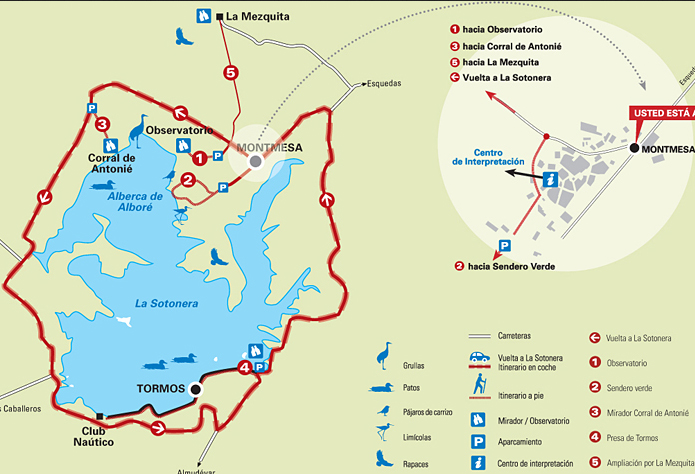
To get at the best places to watch cranes take the track that goes West from Montmesa.
After 300 m. you will cross a small bridge and the track divides into three.
On the left (item 1) you go to the Observatory (600 m, good for photographers), on the right (item 5) you go to La Mezquita where the largest numbers can be seen when they take off and straight ahead it will lead you to some old farm buildings named "Corral de Antonié". For the Corral de Antonié (item 3) turn left at the next junction and left again after 200 m. This spot gives you good views over an older reservoir called Alberca de Alboré, which is now part of the Sotonera reservoir and traditionally the most important resting place for cranes. When Alberca de Alboré is filled, groups of cranes gather on the island close to Montmesa.
Management
The site is protected as an Important Bird Area (IBA), the responsible organisation for this being the Aragón Government, but no management plan exists. Farmers are compensated with European subsidies for damage cranes may produce when feeding.
Since 1980 regular counts are carried out by the Huesca Bird Society called Grupo Ornitológico Oscense (GOO) and published on their website www.avesdehuesca.com.
Information : Grupo Ornitológico Oscence
Translation : Grupo Ornitológico Oscence & Stanislas Zaborowski
Arjuzanx
The reserve of Arjuzanx, a favourite site and a stopover for the cranes 
A former mining area from which the French power company EDF extracted lignite, the site of Arjuzanx has become, after its restoration, a sensitive natural site of great value at European level.
From 1983, the first Common Cranes began to return to the area, which has since become a National Reserve ; every winter, several tens of thousands of cranes use it as migratory stopover while 25,000 to 30,000 of them seek shelter, from mid-October to mid-March, in what has become one of the main wintering sites for the Common Crane in Europe.
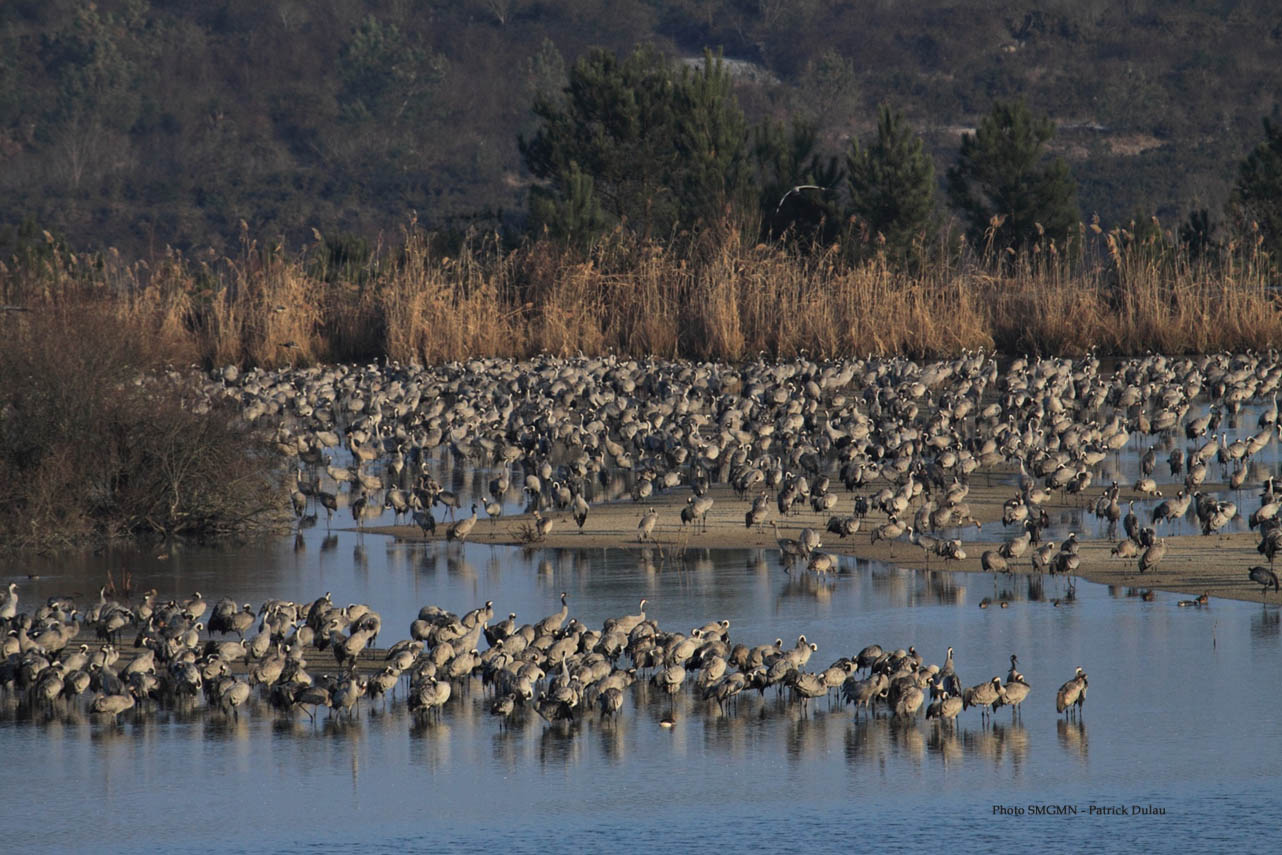
The attractiveness of this place comes also from the fact that, nearby, there are huge farmlands areas (cornfields) which provide the cranes with the food source they need to stay there all winter long.
The area around Arjuzanx is crisscrossed by their daily journeys. From dawn, they leave their bedding areas in order to join the feeding grounds, and, at the end of the day, they find back the tranquility of Arjuzanx's rest places where they return until it gets dark.
Captieux shooting range
![]() The « camp militaire du Poteau » or Captieux shooting range is a site of major importance for birds.
The « camp militaire du Poteau » or Captieux shooting range is a site of major importance for birds.
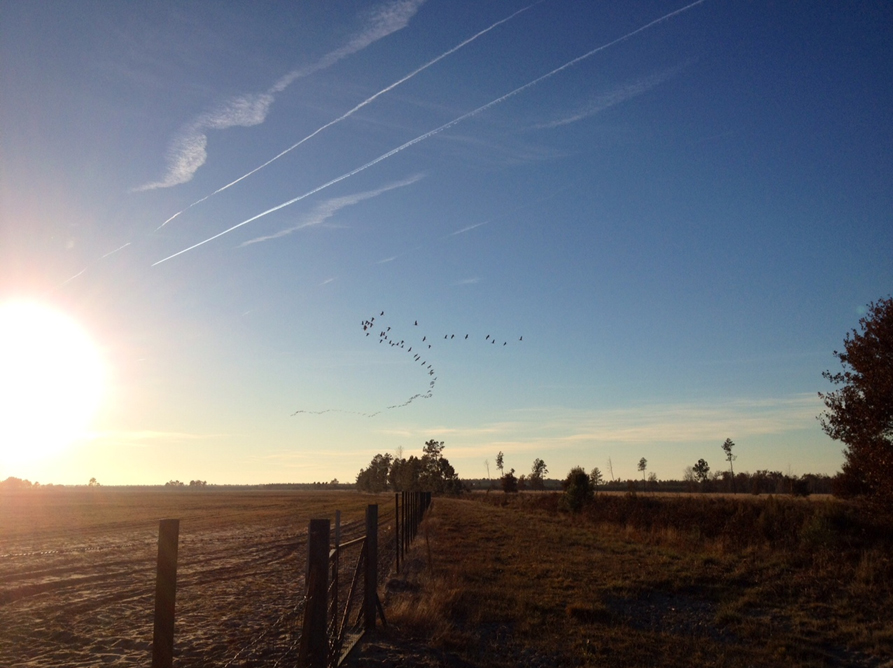 The Common Crane is the emblematic species of this site as it can host up to 10% of the european population of this species. It is also a very important place for the Eurasian Curlew, especially in its lower parts.
The Common Crane is the emblematic species of this site as it can host up to 10% of the european population of this species. It is also a very important place for the Eurasian Curlew, especially in its lower parts.
Location
Located in the eastern part of the Landes plateau, on the territory of 6 communes (Retjons, Lencouacq, Luxey, Callen, Lucmau and Captieux), on two depatments (Landes and Gironde), this military site is mainly used by the French air forces for training. It covers 9175 hectares.
This was an isolated and unhealthy place and, therefore, it was chosen to create a shooting range. Pastoralism was in decline in this sandy and marshy part of the Landes plateau which is situated on two main watersheds and it would have been too expensive to drain the area to grow pinetrees. Drainage works have improved the accessibility to this place without altering the relict original landscapes created by sheep grazing, that you no longer find anywhere else in this region. These landscapes are associated with different types of natural or man-made wetlands (e.g. artificial ponds).
(Documents d’objectifs Site natura2000 FR 7200723 « Champ de tir de Captieux)
Watching cranes :
Cranes can be watched at sunrise when they leave their roosting place or in the evening when they come back from the nearby corn fields where they usually feed. Seing thousands of cranes in their noisy V-shaped flights is an unforgettable moment. To make the best of this scene, which can be different every day, we advise you to stay in one of the gîtes (B and B’s) which are involved in the ecotouristic project of the « Landes de Gascogne ». Your guests will put you information about Cranes and their migrations, bird-watching equipment, maps… at your disposal.
Birdwatching weekends are also organized for those who want to discover more, to share exclusive moments and to exchange with other people.
Grus Gascogna
To ensure the preservation of the Common Crane on our territory, partners have federated since 1992 in a project of study, protection, information and ecotouristic development.
La réserve ornithologique du lac de Puydarrieux (Lake of Puydarrieux)
Location
The dam of Puydarrieux (43.17 N / 00.23 E) is located on a strategic point on the migration route following an axis NE / SO, between the Northern breeding areas, just before the barrier of the Pyrenees (3 000 m) and the wintering regions in Spain.
Technical features
- Mastery of work: Compagnie d'Amenagement des Coteaux de Gascogne
- Objectives: crop irrigation, support of the low-water level for the rivers in the Gers area and drinking water supply.
- A hill reservoir getting water in 1987 with an area of 220 hectares and a capacity of 14 million m3, in place of a pedunculated oak forest.
- The Lake has for original vocation the irrigation, the low water-lever and the conveyance of drinking water.
Regulatory measures and Natura 2000
- Protection order of biotope of 16 June 1989 defining a zone of tranquility.
- Ministerial order of hunting and wild fauna reserve 21 June 1989

- Settlement of a mission for nursery, scientific monitoring and reception of the public initiated by the Departmental Council provided by Soazig Lemur and Valerie Ducasse
- Fittings of ecological engineering in 1994 (lagoons at constant level)Integration to the network Natura 2000 dated 05 January 2006 with the creation of a bird Spa.
Ornithological interest
- In all times cranes used the Lannemezan plateau as a stopover before crossing the Pyrenees.
- Since 1989, the first cranes have a stopped at the tidal range of the Lake of Puydarrieux. Quiet conditions, proximity to water and feeding areas allowed a regular growth of the number of birds wintering there
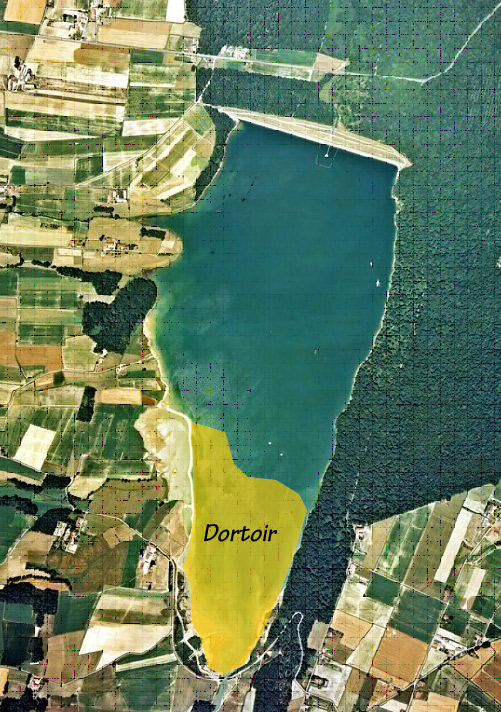 This site for wintering and stopover offers a high variety of food with an important tidal area which becomes a vegetable area as the water level declines. The ground cultivated in the immediate vicinity of the site as well as the feeding areas nearby make up important food resources. The Lake of Puydarrieux fits naturally over the years among the important parking sites for the crane species.
This site for wintering and stopover offers a high variety of food with an important tidal area which becomes a vegetable area as the water level declines. The ground cultivated in the immediate vicinity of the site as well as the feeding areas nearby make up important food resources. The Lake of Puydarrieux fits naturally over the years among the important parking sites for the crane species.
The Lake has an ornithological interest which continues to grow year by year, welcoming over the years nearly 240 species of birds including some remarkable such as the White-tailed Eagle, the Pink-footed goose, the Sociable Plover and the Bonelli's Eagle.
During the last years, the Lake of Puydarrieux hosted during this migration only a few individuals tired or still young and only a few units. This was not the case in February 2002 as more than 4 000 individuals have attended or flew over the site on the day of 25 February.
Attention: The Area of Tranquility settled on the upstream portion of the Lake, the forest in right bank and the farmland in left bank, to ensure the tranquility of the birds, is strictly forbidden to human penetration; the observations can be made from the side of the road
Information : Soazig Lemur et Valérie Ducasse
Translation : Sylvie Gendeau
Gallocanta
 Description
Description
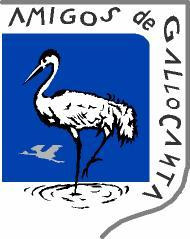
The lake of Gallocanta is a shallow inland saline lake of 1,400 hectares.. It is situated at an altitude of 990 metres in the heart of the Iberian Chain, in the north-west of the Iberian Peninsula, between the provinces of Zaragoza and Teruel (Aragon community).
Underground water has an important influence on the lagoon water level. The Gallocanta Lagoon is the biggest inland brackish lagoon in Europe with 7 kilometers long and 2.5 kilometers wide in its central part. The climate of the area is Mediterranean-continental, with temperatures ranging between -21 °C in winter and 30°C in summer. Rain is uncommon and irregular (450 mm a year), but it snows in winter and there are storms in summer.
The lagoon is surrounded by halophytic vegetation. In some other more localized places, the vegetation is higher (sedge and reed). The surrounding landscape is open, with many corn fields and also a few sunflower fields. All of them are very productive. Maize production began a few years ago thanks to irrigation. Dryness has been extreme in the past years. The importance of floods is decreasing, especially in autumn and winter, and dryness is very strong in summer. The most important floods occurred in the 70s, when we counted the highest number of water birds.
The period 1989/1992 was the last period of important flooding in the lagoon. 260 species of birds have been noticed in this varied biotope, including 126 nesting species.
 Ornithological interest
Ornithological interest
The lagoon is of a great ornithological interest for migratory species, especially in winter for Common Cranes (Grus grus) as it is situated on the migration lane, between the Pyrenees and the cranes wintering areas in Spain. The migration periods coincide with the corn production cycle: sowing in autumn and at the end of winter. Cranes visit us in big numbers during the whole winter (around 25,000 individuals winter here), with occasional peaks of up to 130,000 individuals at the time of the pre-breeding migration. Other migrating birds like storks and flamingos use the water body to rest.
The lagoon surroundings can thus supply cranes with much food, but this means direct consequences on the local agricultural activity.
Anatidae are very abundant on the Gallocanta Lake, especially on wet years when the number of aquatic birds can reach over 200,000 in addition to the breeders staying in spring and summer. During the winter it receives birds from northern latitudes increasing the numbers and variety of this group of birds.
The importance of the lagoon for water birds depends on its flooding level: winter is a very important season for the populations of Common Pochard (Aythya ferina) with a maximum of 80,000 individuals, of Red-crested Pochard (Netta rufina) with 35,000 and of Common Coot (Fulica atra) with 40,000.
On the shores and especially in the places where fresh water enters the lake, among rushes and reeds, we can find insectivorous birds like Sylviidae. Even though they are virtually absent in summer, some of them breed here, but with the post-breeding migration at the end of summer the numbers greatly increase, and it is possible to observe the rare Aquatic Warbler (Acrocephalus paludícola).
In the fields of cereals, it is easy to find Alaudidae and Fringillidae, which form big flocks during autumn and winter, and other steppe land birds: Great Bustard (Otis tarda), Little Bustard (Tetrax tetrax), Black-bellied Sandgrouse (Pterocles orientalis) and the Eurasian Stone Curlew (Burhinus oedicnemus) which usually gathers in small numbers at the end of summer and the beginning of autumn to travel further south where they winter. In the shrubbery no taller than 40 cm, the Dupon’t Lark (Chersophilus duponti), an elusive bird, scarce in the rest of the world, keeps here a healthy population; it is very difficult to see, even during the breeding season when it is really easy to hear its song.
The birds of prey inhabiting this territory are typical of open country with a few species characteristic of woodland. In 2014 there has been a substantial increase in the population of Common Vole (Microtus arvalis), and therefore, so this year was remarkably good to observe this kind of birds in the area, both because of the numbers (tripling that of a normal year) and the diversity: uncommon species for this place like Short-eared Owl (Asio flammeus), Black-winged Kite (Elanus caeruleus) and Bonelli’s Eagle (Hieraaetus fasciatus) were noted. Moving around the heaps of stones and old constructions in the country we can find the more and more unusual Little Owl (Athene noctua).
The Gallocanta Lagoon is listed as ZEPA, it is also listed as a wetland of international importance, according to the RAMSAR Convention. Hunting is forbidden in the lagoon except in August and September (Quail hunting -Coturnix coturnix). -
 Friends of Gallocanta Association (AAG)
Friends of Gallocanta Association (AAG)
 Friends of Gallocanta Association (AAG) is a naturalist entity created by a group of volunteers on 2002, coinciding with the World Bird Day. Its main objectives are the conservation of natural, cultural and environmental heritage of the Gallocanta lake and its basin, the spread of the economic, cultural and environmental values and respect for nature. AAG try to give support to local initiatives and they help with initiatives in the rural areas, and cooperation with other related entities.
Friends of Gallocanta Association (AAG) is a naturalist entity created by a group of volunteers on 2002, coinciding with the World Bird Day. Its main objectives are the conservation of natural, cultural and environmental heritage of the Gallocanta lake and its basin, the spread of the economic, cultural and environmental values and respect for nature. AAG try to give support to local initiatives and they help with initiatives in the rural areas, and cooperation with other related entities.
Since its inception the AAG has promoted and carried out numerous activities that have somehow reversed in the Gallocanta lake and its people positively.
Similarly, it has taken part in various European Congresses on the Common Crane (Sweden, Hungary, Germany, Russia), and has even participated with the Swedish German associations in the ringing, in those countries, of one of the cranes groups which then visit our lands.
The last challenge AAG has developed is the organization of the VIII European Congress on the Common Crane in 2014.
In observing these ringed cranes we have been working on a voluntary basis since 1999.
Informations: Association des Amis de Gallocanta
Regular watchers:
Antonio Torrijo:
José Miguel Pueyo:
Extremadura
![]() The Extremadura is located in the west of Spain, in an area bordering with Portugal; it forms a vast extension of territories mainly flat or with soft mountains crossed by rivers Tajo and Guadiana, and by many tributaries. This immense territory which occupies 41,634 km2, is sparsely populated; its population density is less than that of Spain (25 inhabitants per square kilometer), which has enabled the survival of numerous natural habitats little disturbed by humans.
The Extremadura is located in the west of Spain, in an area bordering with Portugal; it forms a vast extension of territories mainly flat or with soft mountains crossed by rivers Tajo and Guadiana, and by many tributaries. This immense territory which occupies 41,634 km2, is sparsely populated; its population density is less than that of Spain (25 inhabitants per square kilometer), which has enabled the survival of numerous natural habitats little disturbed by humans.
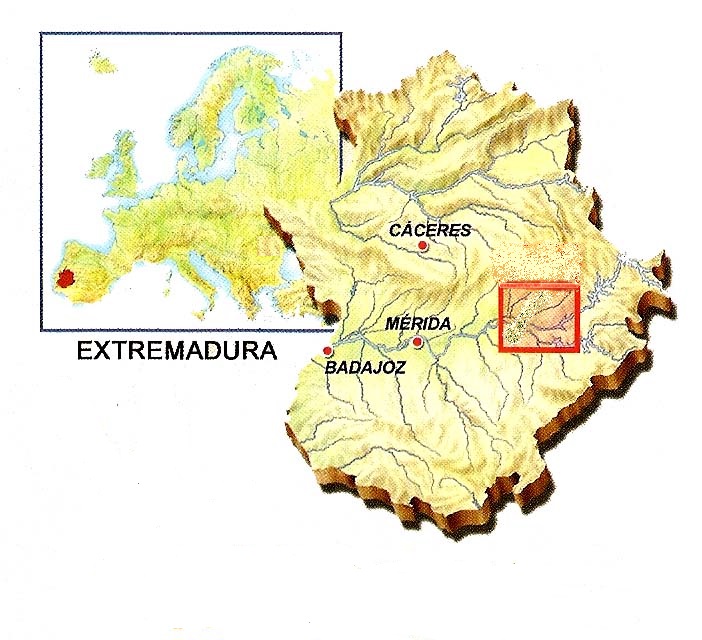
The natural resources of the region are used by a powerful primary sector, with a great importance given to agriculture and livestock, as allows the presence of a significant extension of dehesas (pasture). These dehesas, shaped by oaks, have the characteristic formation of the thinned forest that combines traditional agriculture, livestock, forestry and hunting.
From time immemorial, the dehesa habitat was used by the cranes in their wintering grounds in the west of the Iberian Peninsula, through the fruit of oak called "acorn", which provides a rich and nutritious food for frequent travelers winged. The cranes also benefit from grain fields irrigated or not in the different phases, such as seeding or stubble, and in the latter case, particularly from rice and corn, each time with more intensity, with or without the wooded meadows and a wide variety of different crops: beans, lupins, tomatoes, sunflower, peanut, rapeseed, olive ... The mild climate during the winter and the relative tranquility of these areas offer a suitable environment for their winter stay.
The region has 30 000 hectares of rice crops, which are used by cranes as feeding grounds, as well as roosts, also using the shores of the many existing dam lakes (embalses), open fields and the banks of ponds, especially those that offer calm conditions and are close to their feeding grounds.
The crane is present in 50 areas across the region, occupying about 44% of all of its territory, mainly in the province of Badajoz and, to a lesser extent in the province of Cáceres. The wintering areas are very different in size and population of birds, they vary at each moment of the wintering period. The area called Zona Centro differs from others because it brings together between 60-70% of the total number of cranes that winter in Extremadura and almost 50% of the population of cranes of all Spain.
During the winter period of 2014-2015, censuses were conducted nearly throughout the entire region in December and January, with 121,341 and 132,903 respectively counted cranes; amounts that make up the region as the main area of wintering in Europe.
At the same time, there is in the region a team monitoring the cranes marked that does working pioneer in Spain, performing the most exhaustive control of these birds since the early 1990s, with controls of birds from all countries marked with colour combinations.
This team is covered for a few years by the group "GRUS-Extremadura", whose member are the following:
Manolo Gómez, José A. Román Fernando Yuste, Luis Salguero, JA Sánchez Martín Kelsey, Paloma Iglesias, Anabel Moreno, Borja Maldonado, Chema Traverso, Manolo Calderón, Emilio Peña, Goyo Navarro, José C. López, Alfredo Mirat, José Mr. Hernández y Ehrhardt Hohl
Information : Manuel Gómez Calzado

